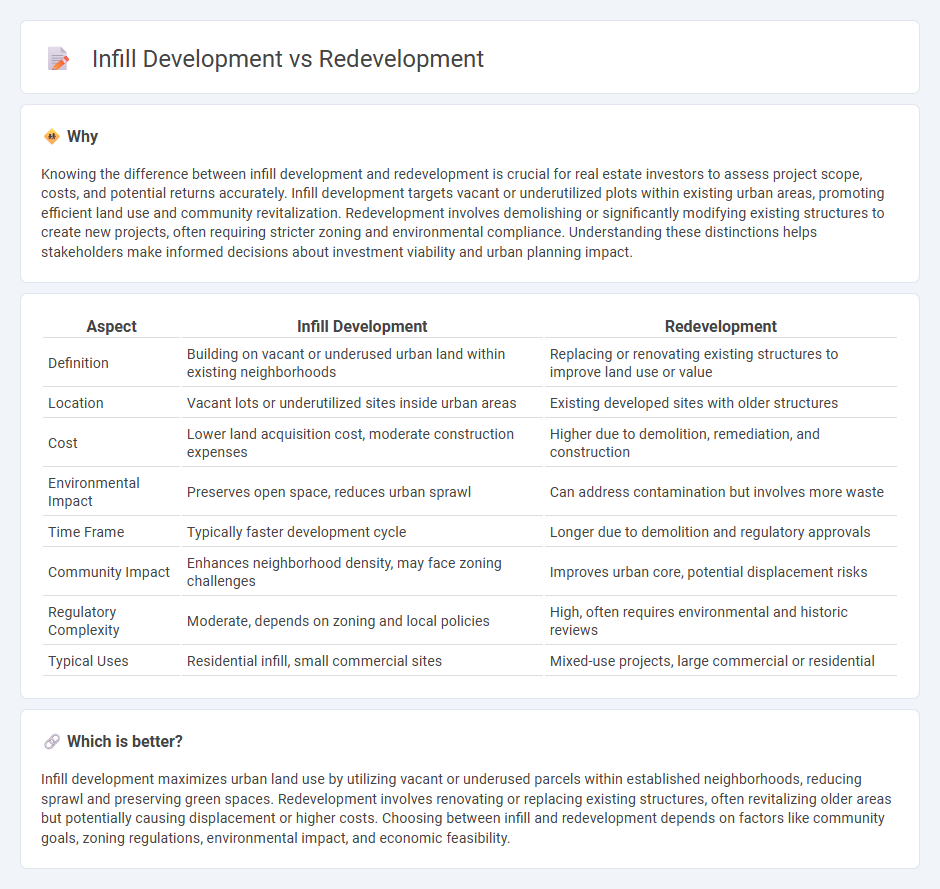
Infill development involves constructing new buildings on vacant or underutilized urban parcels within existing neighborhoods, enhancing land use efficiency and supporting community growth. Redevelopment focuses on demolishing outdated or dilapidated structures to rebuild modern, higher-value properties, often revitalizing entire districts and increasing property values. Explore the key differences and benefits to determine which approach best suits your real estate investment goals.
Why it is important
Knowing the difference between infill development and redevelopment is crucial for real estate investors to assess project scope, costs, and potential returns accurately. Infill development targets vacant or underutilized plots within existing urban areas, promoting efficient land use and community revitalization. Redevelopment involves demolishing or significantly modifying existing structures to create new projects, often requiring stricter zoning and environmental compliance. Understanding these distinctions helps stakeholders make informed decisions about investment viability and urban planning impact.
Comparison Table
| Aspect | Infill Development | Redevelopment |
|---|---|---|
| Definition | Building on vacant or underused urban land within existing neighborhoods | Replacing or renovating existing structures to improve land use or value |
| Location | Vacant lots or underutilized sites inside urban areas | Existing developed sites with older structures |
| Cost | Lower land acquisition cost, moderate construction expenses | Higher due to demolition, remediation, and construction |
| Environmental Impact | Preserves open space, reduces urban sprawl | Can address contamination but involves more waste |
| Time Frame | Typically faster development cycle | Longer due to demolition and regulatory approvals |
| Community Impact | Enhances neighborhood density, may face zoning challenges | Improves urban core, potential displacement risks |
| Regulatory Complexity | Moderate, depends on zoning and local policies | High, often requires environmental and historic reviews |
| Typical Uses | Residential infill, small commercial sites | Mixed-use projects, large commercial or residential |
Which is better?
Infill development maximizes urban land use by utilizing vacant or underused parcels within established neighborhoods, reducing sprawl and preserving green spaces. Redevelopment involves renovating or replacing existing structures, often revitalizing older areas but potentially causing displacement or higher costs. Choosing between infill and redevelopment depends on factors like community goals, zoning regulations, environmental impact, and economic feasibility.
Connection
Infill development and redevelopment are interconnected strategies aimed at maximizing land use efficiency within existing urban areas, reducing urban sprawl, and revitalizing neighborhoods. Infill development involves building on underutilized or vacant parcels in developed areas, while redevelopment focuses on improving or replacing outdated or deteriorated properties. Both approaches contribute to sustainable real estate growth by enhancing infrastructure, increasing property values, and supporting community economic development.
Key Terms
Land Use
Redevelopment transforms underutilized or obsolete urban areas into more efficient land uses, often involving demolition and rebuilding to increase density or functionality. Infill development utilizes vacant or underused parcels within existing urban areas, optimizing land use without expanding city boundaries and reducing urban sprawl. Explore the unique benefits and challenges of both strategies to better understand their impact on sustainable urban planning.
Zoning
Zoning regulations critically influence the feasibility and design of redevelopment versus infill development projects by dictating land use, density, and building form standards. Redevelopment often requires zoning variances or amendments due to the replacement of existing structures, while infill development is typically compatible with current zoning but must address site-specific constraints. Explore detailed zoning impacts to optimize your development strategy.
Density
Redevelopment often involves replacing older, underutilized properties with higher-density buildings to maximize land use efficiency and urban growth potential. Infill development targets vacant or underused parcels within existing urban areas, increasing density by integrating new structures without expanding city boundaries. Explore the benefits and challenges of each approach to better understand their impact on sustainable urban density.
Source and External Links
Redevelopment - Redevelopment is any new construction on a site that has pre-existing uses, aimed at revitalizing the physical, economic, and social fabric of urban spaces.
APA Policy Guide on Public Redevelopment - This policy guide provides guidelines for effective public redevelopment, emphasizing the use of incentives over eminent domain to achieve public purposes.
What Is Redevelopment? - Redevelopment describes projects that construct new buildings and land uses on previously developed sites, enhancing urban areas through renovation or new construction.
 dowidth.com
dowidth.com